-
Engine1.6L I4
-
Power138 HP / 123 LB-FT
-
Transmission6-Speed Auto
-
DrivetrainFront-Wheel Drive
-
Curb Weight2,690 LBS
-
Seating2+3
-
Cargo23.7 / 53.4 CU-FT
-
MPG29 City / 36 HWY
The Soul is an unqualified hit. Sales of this playful econobox have increased year-over-year since it was introduced in 2009 as a 2010 model, with over 100,000 people bringing one home last year alone. In fact, the Soul was Kia's second-best-selling model in 2011 behind the Sorento, beating out the critically acclaimed Optima, gorgeous Sportage and entry-level Forte.
Not only is the Soul outperforming products in its own portfolio, it's also slaughtering what little competition there is out there that lines up straight against it. One could argue that the Soul competes with any sub-$20K five-door hatchback on the market, but most agree that buyers considering a Soul are also likely to check out the Scion xB and Nissan Cube. These three vehicles make up a tiny selection of boxy alternatives for people who shun the norm, but in just a few short years, the Soul has run away with the segment, accounting for 76-percent of its sales last year alone.
There are a number of reasons for the Soul's success, not the least of which is an award-winning marketing campaign that stars a peace-keeping troop of intergalactic breakdancing hamsters. Aside from rhythmically inclined rodents, the Soul has achieved what the xB and Cube haven't because its unorthodoxy ends long before alienation sets in. A lot of people just find it charming, and it covers the basics of A-to-B transportation as well as any other vehicle with a starting price below $14,000.
But the Soul wasn't perfect, as evidenced by the number of upgrades it received for the 2012 model year. With new styling tweaks inside and out, new and updated engines and transmissions along with additional features, the 2012 Kia Soul is a lot newer than one would expect of a vehicle just three years old. And while normally automakers are prone to sending out loaded models to review, Kia was confident enough to deliver us this Base 1.6L model for a week-long test.
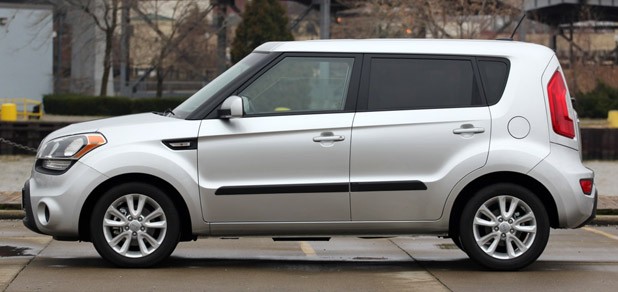
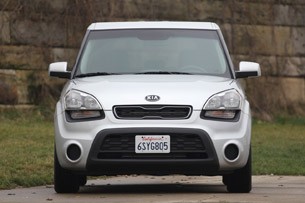
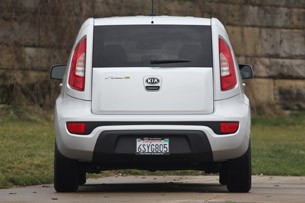
Kia trimmed its Soul lineup for 2012 by dropping the range-topping Sport model, and so now it offers only three trims: Base, + and !, which when spoken are simply referred to as Base, Plus and Exclaim. The Plus and Exclaim both come with Kia's new 2.0-liter "Nu" four-cylinder engine that produces 164 horsepower and 148 pound-feet of torque, significantly more than the 2.0-liter it replaces. Normally we're interested in testing the most powerful engine an automobile has to offer, but in this case we have our eye on the Soul's base engine: a new gasoline direct-injected (GDI) 1.6-liter four-cylinder rated at 138 horsepower and 123 pound-feet of torque.
Why? Kia says the take rate on the Soul's base engine for its first two model years was only 35 percent, suggesting most people opted up for the 2.0-liter's power advantage. We suspect that may change thanks to this new 1.6-liter, which is already earning accolades. Ward's Auto named this powerplant to its annual list of 10 Best Engines, where it shares the honor with such gems as Audi's 3.0-liter TFSI Supercharged V6 and BMW's N55 Turbocharged Inline-6. You don't keep company like that unless you're better than the average base engine.Normally we're interested in testing the most powerful engine an automobile has to offer, but in this case we have our eye on the Soul's base engine.
We were also interested in testing out Kia's new Idle, Stop & Go (ISG) system, included in the Eco package that's available on Base 1.6L and Plus 2.0L models. Supplementing the ISG system, the Eco package also includes low rolling-resistance tires on special 16-inch alloy wheels and a more robust 56 ampere-hour sealed AGM-type battery. Systems that shut down an engine when a vehicle isn't moving are nothing new; hybrids have been using them since Day One. Their use in non-hybrids, however, are relatively new and usually reserved for thirstier, more feature-rich luxury vehicles – at least in this market. While the technology continues to slowly trickle down as laws to increase fuel economy become more strict, to find such a system on the sub-$15K Soul is still an eye-opener.
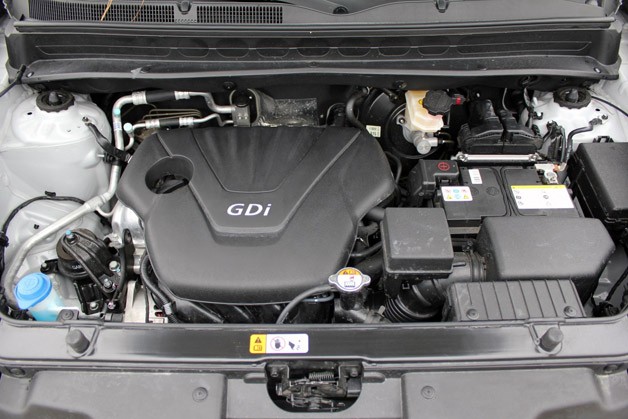
And so it was that our test vehicle came to be a 2012 Kia Soul Base 1.6L Eco. Kia now offers Soul buyers a pair of six-speed transmissions – one manual and the other automatic – instead of last year's four-speed A/T and five-speed M/T. Opting for the auto significantly raises the Base 1.6L's rock-bottom starting price of $13,900 to $15,700. Add to that our tester's Base Eco Package for $1,000, carpeted floor mats for $95 and a $750 delivery charge, and we wind up with an as-tested price of $17,545.
Fortunately, all Souls share the same trendy shape regardless of price. For 2012, Kia has completely redone both the front and rear fascias, paying particular attention to the lighting elements. While Exclaim models now see the road ahead through projector beams and LEDs, Base and Plus models get new multi-reflector headlights. Larger fog lamp openings that go unfilled on our base model, new taillamps, a slightly redesigned rear bumper, new side mirrors and different door handles round out the exterior tweaks. Our Eco-equipped model also takes a pass on the Soul Base 1.6L's standard wheel covers for a set of more attractive 16-inch alloy wheels.The Soul's design is quirky without being silly and unique without being weird.
We suspect a large reason for the Soul's success has been its boxy, beveled design. It's quirky without being silly and unique without being weird. While tweaked for 2012, it's still recognizable as the same hip urban runabout it was before. Spotters looking to pick out the new Soul need only look at the size of those larger fog lamps, which give away the 2012 model instantly.
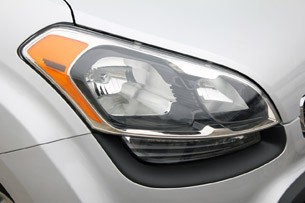
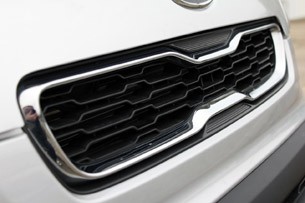
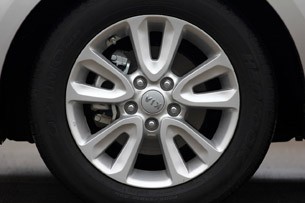
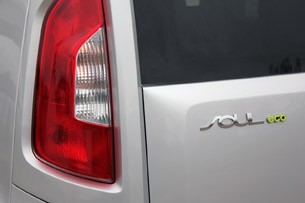
One would be hard-pressed, however, to differentiate Souls on interior alone. The cabin tweaks for 2012 are more subtle than those visible on the exterior. Look closely and you'll see an ever-so-slightly altered center stack with different radio station preset buttons and new knobs for the climate control system. The transmission console is also redesigned, and Kia has changed up some of the upholstery patterns. Our tester featured the basic black interior with cloth fabric in a tasteful pattern, which we prefer to the showy "Soul"-branded seat upholstery in Plus models.
While hard plastics and basic fabric materials don't impart a premium atmosphere, the Soul doesn't come across as cheap because of how much standard equipment you can see from the driver's seat. The nicely shaped steering wheel features cleanly integrated controls for the cruise control and Sirius satellite radio-equipped audio system, both standard. Below the center stack are a pair of standard inputs for auxiliary cables and USB, as well as two 12V outlets. The new transmission console even features a gate for +/- manual shifting, all standard.You get each of these items in a Base 1.6L and Exclaim 2.0L alike, regardless of the fact that their base prices are $5,300 apart.
And then there's the standard equipment you can't see, like wireless Bluetooth connectivity for phones and audio players and even Hill-Start Assist Control that keeps the vehicle from rolling backwards when accelerating from a stop on an incline. You get each of these items in a Base 1.6L and Exclaim 2.0L alike, regardless of the fact that their base prices are $5,300 apart. And to that point, our Base 1.6L's 23.7 cubic-feet of rear cargo space, which includes a hidden underfloor compartment and expands to 53.4 cubic-feet with the 60:40-split rear seat folded forward, comes at no extra charge.
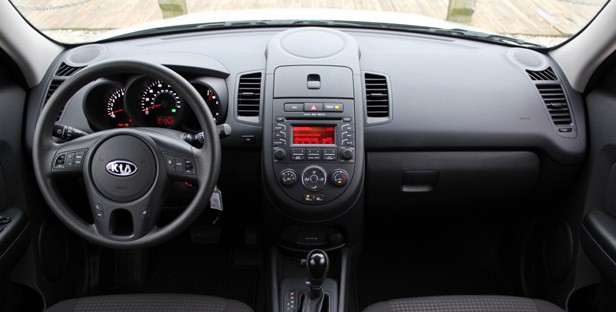
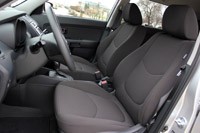
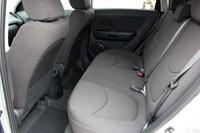
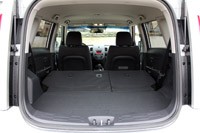
What will make or break the Base 1.6L, indeed what broke the prior base model and had the majority of customers opting against it, is its powertrain. While identical in size to the outgoing base powerplant, the new 1.6-liter four-cylinder benefits from direct injection to produce 138 horsepower at 6,300 RPM and 123 pound-feet of torque at 4,850 RPM. Mated to our optional six-speed automatic and supplemented by the Eco Package's ISG system, the powertrain is good for an EPA-rated 29 miles per gallon in the city and 36 mpg highway. For comparison's sake, if you dropped the Eco Package, the Base 1.6L would still earn 27 mpg city and 35 mpg highway.
After driving the Soul Base 1.6L Eco in and around suburbia for a week, we're ready to throw our weight behind Ward's Auto and its engine accolade, if for no other reason than the improvement in the feeling of power you get from behind the wheel. This 138-hp 1.6-liter "base" engine feels stronger and more tractable than even last year's optional 142-hp 2.0-liter engine. We've seen time and again how the addition of direct injection, a technology that introduces fuel directly into the cylinder rather than its intake ports, can transform the character of an engine. It's happened again here, but there are a couple of other reasons why this engine shines so brightly.This 138-hp 1.6-liter "base" engine feels stronger and more tractable than even last year's optional 142-hp 2.0-liter engine.
The first is Kia's decision to pair it with a new six-speed automatic transmission instead of last year's four-speed automatic. Much of the outgoing Soul's lethargy can be attributed to its tiny powerband being shared by only four gears. Carving up the spectrum with two additional cogs gives the engine a fighting chance to find its sweet spot when you're looking for power to pass or enter highways. While we're reticent to describe the base Soul's quickness as sporty, it's definitely spry and squirts through traffic with an ease it didn't have before.
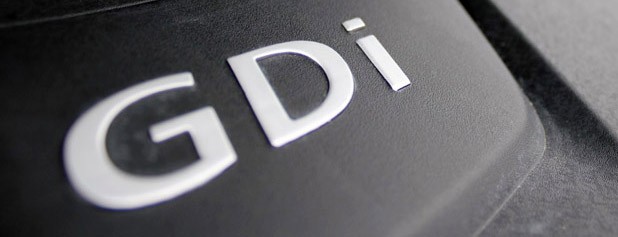
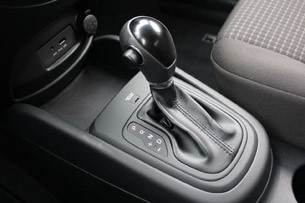
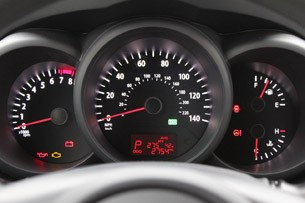
The second thing that plays into this engine's favor is Kia's efforts at reducing levels of noise, vibration and harshness (NVH). One of the original Soul's main turn-offs was its interior decibel levels and the loud buzzing coming from under the hood at highway speeds. The new six-speed transmission with its taller final gear ensures the engine isn't working as hard as it used to on the highway (70 mph equals about 2,500 RPM). What's more, Kia has added insulation to the underside of the hood, included a thicker dash insulation panel and fitted the A-pillars with noise-absorbing pads. There are also new exhaust silencers, vibration dampers and vinyl sealing on the door trim. The result of this effort to expunge unwanted volume is both readily apparent and entirely welcome. The Soul is now as quiet as some luxury cars inside, making the engine seem almost as smooth and silky in operation as something wearing a roundel or quartet of rings.
While the Soul's 1.6-liter base engine has become a mature and capable powerplant, we wish other parts of the Soul had received equal attention from engineers. The steering in particular is both light and precise, but it also requires a lot of corrections to keep the Soul tracking straight ahead. The electrically assisted rack-and-pinion setup also has the habit of aggressively returning back to center, sometimes even snapping the steering wheel back into place with such force that it unsettles the chassis. Confidence inspiring it was not, but we eventually acclimated ourselves to the helm's sensitivity and even found it particularly well-suited for slaloming through parking lots. And while we doff our cap to Kia for making disc brakes at all four corners standard, again, the left pedal's sensitivity takes some getting used to.
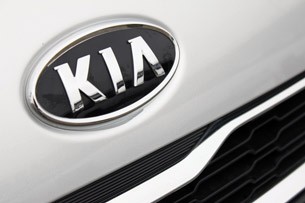
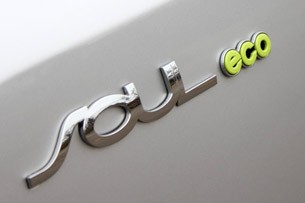
This doesn't mean the Soul is a handful to drive. Once your hands and feet fine-tune their inputs, the Soul is exactly the type of dart-and-turn urban transport you would expect at this price point. We even found the highway ride to be surprisingly comfortable despite the vehicle's relatively short wheelbase. The solid structure, squeak-free build quality and aforementioned reductions in NVH levels could've revealed an unsorted suspension that allows every little impact past, but the MacPherson struts up front and torsion beam rear suspension handle pockmarked roads with aplomb.
The new-for-2012 Idle, Stop & Go system, however, carried itself with less grace. When we first drove the new Soul, Kia remarked that the start/stop system would only offer a three-percent improvement on the EPA's city cycle. Such a small gain had us both wondering why Kia would even bother to offer the system at all and speculating that the estimate was intentionally low so as to delightfully over-deliver in real world use. In our case, the system didn't seem to have an effect on fuel economy at all. The first time we went to fill up, we discovered that the Soul had only hit 25.16 miles per gallon combined, despite the trip computer showing anywhere from 27.5-28.0 mpg. Either way, both figures fell below the official EPA rating of 29 mpg in the city.
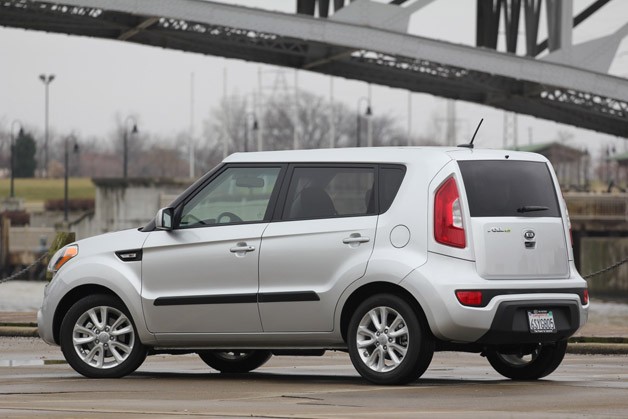
Why so low? Even supposing our own calculation contained an error, it's tough to say why even the trip computer's average estimate failed to meet the EPA rating for mileage in the city. We can suggest, however, why the ISG system didn't have a more significant impact on our efficiency: conditions. The parameters that must be met before the engine turns off are so specific that the event rarely happens, and when it does, the engine typically stays off for mere moments. The one condition that cancels ISG most frequently is that the Soul must hit 5 mph since the last idle stop, which means that inching forward in a traffic jam or drive thru (or at a stop light after someone turns) will restart the engine and keep it on. Other conditions that keep ISG at bay include the front defroster being on, using the highest fan speed setting when the A/C is on and even the outside temperature being below 28.4 or above 95 degrees. The system is also manually defeatable at the touch of a button located to the left of the steering wheel.
These conditions were put in place for a reason, including a desire to keep the accessory and climate systems functioning uninterrupted at all times, but in our case, they kept the system from showing any real world improvement in fuel economy. If being ineffective weren't enough, restarting the engine after an idle stop also sends an unpleasant shudder up through the brake pedal. This transition from off to on is simply not as seamless as other stop/start systems, so much so that Kia recently decided to delay the availability of ISG until it can remedy the system's roughness.Kia correctly targeted for improvement the precise areas of the Soul that were our causes for complaint.
Fortunately, the Soul needn't be judged solely on its ISG system, which will likely improve with future iterations and for now can be avoided by not checking the Eco Package box on your order sheet. You'll save a grand and still get a fun and affordable five-door hatchback that feels anything but base. Indeed, Kia has correctly targeted for improvement the precise areas of the Soul that were our primary causes for complaint, and in doing so, it may have turned one of its hot sellers into its new best seller.

Sign in to post
Please sign in to leave a comment.
Continue